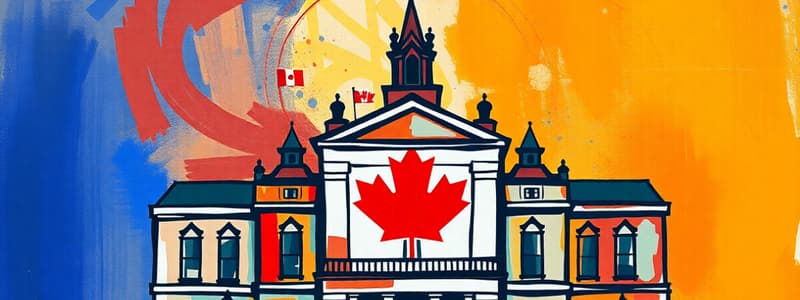Podcast
Questions and Answers
What is the primary role of the executive branch?
What is the primary role of the executive branch?
- Making and changing laws.
- Presiding over the court system.
- Interpreting the constitutionality of laws
- Carrying out government plans and policies. (correct)
Which branch of government is responsible for creating and repealing laws?
Which branch of government is responsible for creating and repealing laws?
- The Provincial Court
- The Legislative Branch (correct)
- The Executive Branch
- The Judiciary
What defines substantive law?
What defines substantive law?
- Laws that define rights, duties, and obligations of citizens. (correct)
- Laws that apply to the federal system
- The process of enforcing laws
- Laws governing relations between independent nations
Which of the following best describes procedural law?
Which of the following best describes procedural law?
What is the role of the judiciary branch?
What is the role of the judiciary branch?
What characterizes the 'second reading' stage in the process of passing a law?
What characterizes the 'second reading' stage in the process of passing a law?
In the context of amending the constitution, what approvals are generally required?
In the context of amending the constitution, what approvals are generally required?
A law is deemed invalid if it violates what?
A law is deemed invalid if it violates what?
What is the primary focus of criminal law?
What is the primary focus of criminal law?
What does constitutional law primarily address?
What does constitutional law primarily address?
Flashcards
Executive Branch
Executive Branch
The administrative branch responsible for carrying out government plans and policies.
Legislative Branch
Legislative Branch
The branch of government with the power to make, change, and repeal laws.
The Judiciary
The Judiciary
The branch of government responsible for presiding over Canada's court system.
International Law
International Law
Signup and view all the flashcards
Domestic Law
Domestic Law
Signup and view all the flashcards
Substantive Law
Substantive Law
Signup and view all the flashcards
Procedural Law
Procedural Law
Signup and view all the flashcards
Public Law
Public Law
Signup and view all the flashcards
Criminal Law
Criminal Law
Signup and view all the flashcards
Constitutional Law
Constitutional Law
Signup and view all the flashcards
Study Notes
- Constitution was brought home between 1982 giving Canada authority to change the constitution.
- Amending formulas need approval from Parliament plus 2/3 of provinces to change the constitution.
- Charter rights and freedoms are rights entrenched in the constitution.
- Any law that violates these rights is invalid.
Executive Branch
- Administrative branch of government that carries out the governments plans and policies.
- Federal: King Charles III
- Provincial: King Charles III
Legislative Branch
- The branch of government that can make change and repeal laws.
- Federal: Governor General
- Provincial: Lieutenant
The Judiciary
- Branch of government responsible for presiding over Canada's court system.
- Includes provincial court of appeal, superior court, provincial court.
Passing Law
- First Reading: Bill is first introduced and given a first reading.
- Second Reading: The bill is debated.
- Third Reading: Debate is restricted to contents of the bill.
- Federal System: Steps are repeated in the Senate.
- Provincial System: Lieutenant must sign the bill.
Categories of Law
- International Law: Laws that govern the relations of independent nations.
- Domestic Law: Made and enforced within a nation
Domestic Law
- Substantive Law: Defines the rights, duties, and obligations of citizens.
- Procedural Law: Ways to enforce substantive law (Habeas Corpus).
Substantive Law
- Public Law: Laws that apply to everyone
- Criminal: Behavior that causes harm to society.
- Constitutional: How the country is run and the structure of power.
- Administrative: How government agencies operate.
Studying That Suits You
Use AI to generate personalized quizzes and flashcards to suit your learning preferences.




